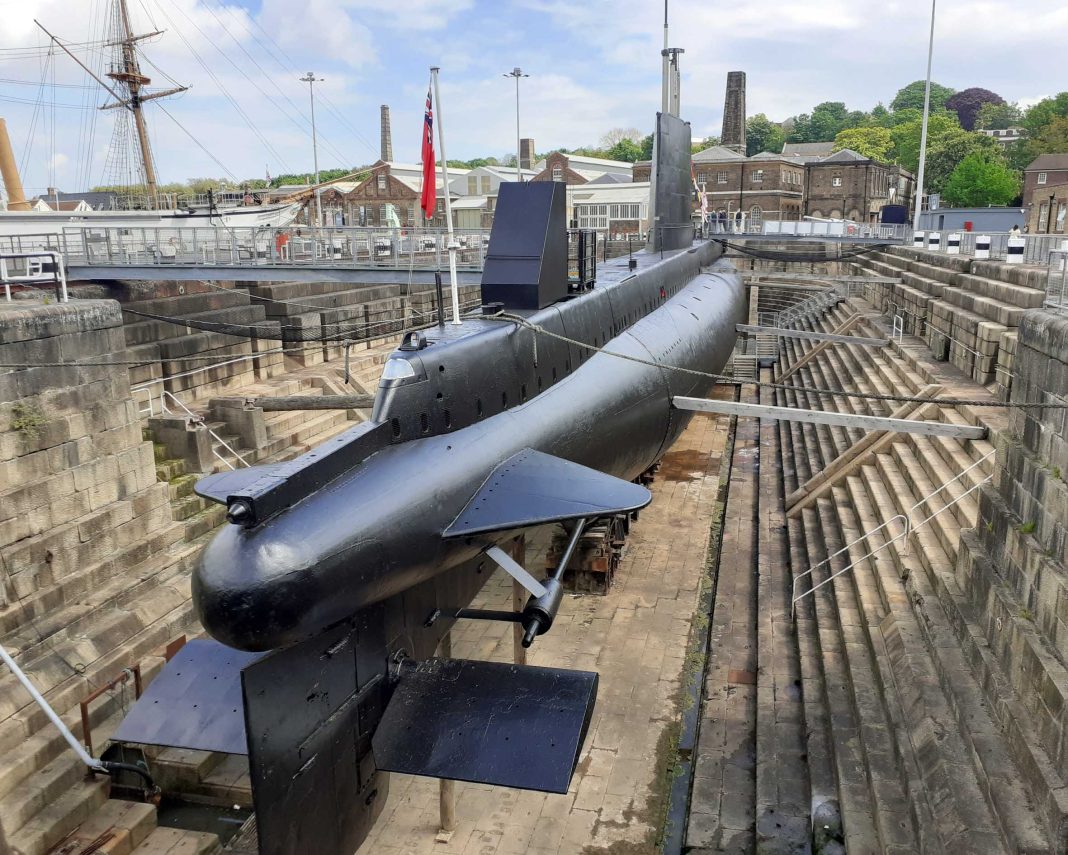OCELOT at 60 by Patrick Boniface
HMS Ocelot is a survivor. Unlike most of her sisterships of the Oberon class diesel electric submarines, she has been preserved for future generations and it is hoped that following restoration work she will continue in this role for many years to come.
On Saturday 7 May 2022 former submariners who served on her and her sisterships and some of the dockyard workers from Chatham Dockyard where she was originally built and is now on permanent display celebrated her 60th anniversary.
Unveiling a celebratory plaque to mark the event the Historic Dockyard’s Chairman Admiral Sir Trevor Soar, and a former commanding officer of the submarine praised the recent restoration work undertaken on making the submarine more accessible and visually more attractive.
‘In her build, in her active service life and now as something central to the Historic Dockyard she has touched many lives.
‘In her 29 years of service the submarine served in the Atlantic, Baltic, Mediterranean and the Pacific. I was very fortunate to command her from 1987 to 1990 during which we went down to the South Atlantic, around the Falklands to the Pacific, Panama, West Indies, America. It was tough but someone had to do it.’
She was paid off in August 1991 and returned to Chatham on 12 July 1992 and it was perhaps coincidence that Admiral Sir Trevor Soar was actually the Captain of HMS Chatham, and brought the ship at the same time as Ocelot was reunited with the Dockyard.
Since then, Ocelot has been restored and initially opened to visitors in 1995 and over the last 27 years she has been visited by thousands of people which, of course, caused wear and tear.
Through the generous funding of the Friends of the Submarine Service, Friends of the Submarine Museum and other benefactors she has been given a much needed facelift and represented as if she were still in service.
The work was overseen by James Morgan, the Trust’s Heritage Engineering and Historic Ships Manager who said: ‘there was a sense that there was a story, but we hadn’t fully told it. We noticed that bunks were in the wrong places, there was lots of materials missing and damage to surfaces and the ship was generally dark [inside].
‘I am not sure how to describe it, when you went through there was almost a sense of foreboding, almost like it was abandoned.
‘When she arrived in 1992 lots of things were removed because of The Official Secrets Act there were O boats still operating with the Indian Navy and other navies. Much of her had been stripped out for that purpose, now non-of that equipment is part of the Official Secrets Act and we need to put stuff back.
‘One of the first things we noticed was the chart plotting table, the plotter was there but not the table, the rig to fire the torpedoes similarly was there but sitting on a table not bolted to the wall and the TCC computer was missing.’
James Morgan continued: ‘We worked with HMS Otus, an O class boat museum in Germany. We’ve been talking to them quite a lot because she’s as she left service everything from day dot of decommissioning everything is where it should be, so they were a really good museum to talk to and their volunteers are absolutely amazing.
‘The National Museum of the Royal Navy Gosport and HMS Alliance, the team of curators there were absolutely fantastic. They helped us with plenty of walk through’s of their submarine to think ‘how can we bring this amazing experience.
‘They received £1.2 million for their reinterpretation which is amazing, but we had nowhere near that. So, taking various key points from them. Finally, HMAS Onslow, the National Maritime Museum of Australia.’
As part of the restoration Ocelot received 650 litres of paint. ‘We worked with a big maritime paint suppliers Jotun. We highlighted a material paint that would work both afloat and in dry conditions. We had a special grey coating especially made for Ocelot.’
The former gloomy interior has now been transformed. ‘She is now as bright as it is outside. We have highlighted every single light fitting onboard, removed those that are museum era, refitted correct MOD lighting and instead of removing internals we fitted LED bulbs.’
When it came to Ocelot’s batteries James Morgan and his team spent three months prior to the restoration venting the existing batteries of any potential gas build up.
While most of the repairs and restoration were undertaken by the volunteers at Chatham Historic Dockyard some of the work was taken out of the dockyard, one example being the original looking bunk covers were manufactured by a local seamstress. Authentic of the period VCR machines and TV sets were obtained via a Facebook appeal.
One thing that is hard to replicate is the sound of an operational Cold War submarine, but Ocelot has now been given that visceral sensation too.
‘We worked with the BBC Sound Archive, and we found various recordings from the mid-60s, and they provide us with a very realistic and authentic soundscape that you hear today. The one sound that isn’t manufactured and the true sound of HMS Ocelot is her radio room recorded by Max, one of our staff utilising the actual equipment onboard.’
Photo captions:
Admiral Sir Trevor Soar Chairman of Chatham Historic Trust and Richard Morsley Chief Executive of Chatham Historic Trust
James Morgan in front of HMS Cavalier, another of Chatham Dockyard’s three historic warships
Submariners and shipyard workers who built HMS Ocelot gather in front of the submarine to celebrate her 60th anniversary.


